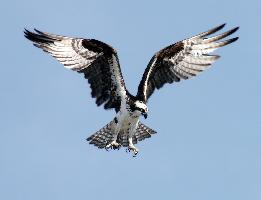
Poids et mesures
| Longueur | de 50 à 66 cm |
|---|---|
| Poids | de 0,9 à 2,1 kg |
| Envergure des ailes | de 127 à 180 cm |
Description de l'animal
The Osprey (Pandion haliaetus), often known as the sea hawk, fish hawk, or river hawk, is a diurnal, fish-eating bird of prey with a cosmopolitan range. This magnificent bird is notable for its striking appearance and specialized hunting abilities, making it one of the most widespread and well-recognized birds of prey across the globe.Characteristically, the Osprey stands out with its impressive wingspan, ranging from 150 to 180 centimeters (59 to 71 inches), designed for efficient flight over water bodies. Adult Ospreys have a distinctive white underbelly and chest, contrasting sharply with their dark brown upperparts. Their heads are white with a dark mask across the eyes, reaching to the sides of the neck. This unique facial pattern aids in glare reduction while hunting. Their eyes, keen and adapted for spotting prey from a distance, are a piercing yellow, reflecting their predatory nature. The Osprey's talons are another remarkable adaptation; each toe is reversible, allowing them to grasp their slippery fish prey with two toes in front and two behind.
Ospreys are found near freshwater lakes, rivers, coastal waterways, and estuaries. They exhibit a strong preference for habitats where fish are abundant, as fish constitute 99% of their diet. Their hunting technique is a spectacular display of aerial prowess; they hover over water, keeping an eye out for fish, and then dive feet first, sometimes completely submerging, to snatch their prey with their powerful talons. After capturing a fish, an Osprey will adjust it in its grasp mid-flight to a more aerodynamic position, head forward, before returning to its nest or perch to eat.
Breeding behavior of the Osprey is as fascinating as its hunting rituals. They are mostly monogamous and often return to the same nesting site year after year. Nests are typically built high off the ground to avoid predators, on structures like dead trees, cliff edges, or even man-made platforms. Both parents partake in nest construction, using sticks and lining the inner cup with softer materials. The female lays 2 to 4 eggs, which are incubated for about a month. The male primarily hunts during this period, providing food for the female and, eventually, for their chicks.
Globally, Ospreys are considered a species of least concern by the International Union for Conservation of Nature (IUCN), thanks to their wide distribution and increasing population, particularly in areas where they had previously declined due to pesticide use. Conservation efforts, including the erection of artificial nesting platforms and the ban on harmful pesticides like DDT, have played significant roles in their recovery.
In many cultures, the Osprey is admired for its majesty and hunting prowess. It is a symbol of purity, speed, and power, often featured in heraldry and literature. The bird's incredible journey from near endangerment to a thriving population is a testament to the resilience of nature and the positive impact of concerted conservation efforts.
Carte de répartition

Nouvelles photos d'animaux
Top 10 des animaux
- Common reed warbler (Acrocephalus scirpaceus)
- Diana monkey (Cercopithecus diana)
- Moustached guenon (Cercopithecus cephus)
- Galápagos tortoise (Geochelone nigra complex)
- Dolphin gull (Leucophaeus scoresbii)
- Hen harrier (Circus cyaneus)
- Brant (Branta bernicla)
- Stone loach (Barbatula barbatula)
- Common house mosquito (Culex pipiens)
- Colossal squid (Mesonychoteuthis hamiltoni)